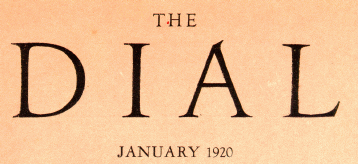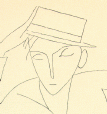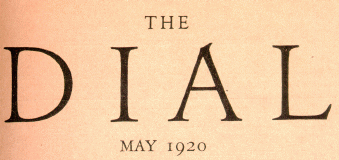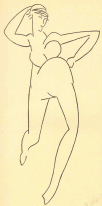
figure 2
THE DIAL's "WHITE-HAIRED BOY":
E. E. Cummings as Dial Artist, Poet, and Essayist
[Spring New Series 1 (1992): 8-27]
It is not every day that a virtually unknown writer and artist suddenly acquires a direct pipeline to the most promising arts journal of its day in America. Yet such was the fortune of the twenty-five year old E. E. Cummings. As he acknowledged to his father in May 1920: "I need not say that I am extraordinarily that is as usual lucky in having what amounts to my own printing press in Thayer and Watson." [1]
Cummings was referring here to the scrupulous care with which The Dial's new editor and publisher reproduced the typographical idiosyncrasies of his poems. But he also must have realized the larger opportunities that this "printing press" offered his nascent careers as poet, painter, and essayist. Just in the five months preceding this letter--the five months since Scofield Thayer and Sibley Watson had acquired The Dial and redirected its programme--they had published twelve of Cummings' poems, four of his line drawings, and his long essay on Gaston Lachaise. Cummings thus appeared in three of the new Dial's first five issues. His work would appear in eighteen subsequent issues during that journal's brilliant decade, an output comprising in all thirty-seven poems, excerpts from the play Him, four essays, twenty-two line drawings, and reproductions of two oil paintings and four washes (see Appendix). Little wonder, then, that Ezra Pound referred to Cummings as The Dial's "white-haired boy," or that Alfred Kreymborg considered him that review's "arch discovery." [2] Indeed, it was through this distinguished medium that many partisans of Modernism first [end page 9] encountered Cummings' distinctive poems as well as his art and prose.
Cummings' prominence in what proved to be the preeminent Modernist journal of the 1920s raises interesting questions pertaining not only to his early career, but also to the impeccable reputation of the review itself: How did he become so fortunately situated? How did The Dial portray his artistry? How good is it in retrospect? And what does the work, in turn, imply about The Dial's aesthetic preference and standards?
Cummings' friendship with Scofield Thayer and Sibley Watson went back to their days together at Harvard in the early teens. While all three were friends and shared a passion for the arts, Thayer and Watson also served (among others) as Cummings' aesthetic mentors. Watson developed his interest in the French Symbolist poets, Thayer, a few years Cummings' senior, introduced him to Modernist styles in painting, as well as to Wilde, Beardsley, Joyce, and Eliot. Even at Harvard, Thayer acted as Cummings' literary benefactor, soliciting his poems for The Harvard Monthly, which Thayer served as Secretary. Through Thayer's intercession, Cummings later joined the editorial board of the Monthly, a board that provided the founding staff of The Dial five years later. [3] After leaving Harvard, Thayer continued to support Cummings' artistry, commissioning several oils from the fledgling painter.
Cummings responded to his Harvard friends artistically as well as personally. He devoted sonnets to both Thayer and Watson and often sketched Thayer's distinctive features in varying degrees of abstraction (fig. 1), here caricaturing the latter's typically upraised eyebrow and tiny bow mouth. His ties to Thayer acquired a more intimate and complex dimension, however, when Thayer became engaged to Elaine Orr in 1916. Charmed by Orr's beauty as much as by Thayer's friendship, Cummings celebrated their marriage with a long Epithalamion. But as Thayer grew increasingly remote from Elaine, maintaining a separate apartment from hers, Cummings gradually replaced him in her affections (with Thayer's tacit approval) and fathered a child by Elaine in December l919. This quadrangle, while uncomfortable for Cummings (since he could not acknowledge his [end page 10] paternity) and even worse for Elaine (who was largely ignored by both men once her baby was born), nevertheless did not damage Cummings' friendship with Thayer. For Thayer's concerns were less with his wife's baby than with the birth of a new journal that he and Sibley Watson were midwifing that same month.
Their first issue of The Dial in January 1920 featured seven of
Cummings' poems next to four line drawings entitled "National Winter Garden
Burlesque." The poems are a mixed bag. Several were originally written at
Harvard in the ornate, derivative style Cummings then affected. Two poems,
"little
tree" and "why did you go" adopt a child's voice and view and ooze sentimentality.
Even the war poem, "the
bigness of cannon / is skilful,"
muffles the horror of artillery casualties in abstraction and understatement:
"i have seen death's clever enormous voice / which hides in a fragility of
poppies.... I have seen all the silence / filled with vivid noiseless boys."
Only one poem, the famous "Buffalo
Bill 's" emerges from the group as a fully formed sample of Cummings'
new poetics. Not surprisingly, it aroused more controversy than the others.
Sibley Watson's mother objected to its use of "Jesus" as an expletive; more
secular readers were shocked by its visual appearance: its arrowhead structure,
its phrases run together or strung out over several lines, its punctuation
almost entirely missing. The reshaper of poetic conventions had made his
debut.
| The four burlesque line drawings accompanying these poems are also uneven. While the one of Jack Shargel (fig. 2--[on page 12 in original]) wittily captures the homely comedian strutting like a stripper, the two drawings of real strippers at work are pedestrian, even if they do signal The Dial's unsnobbish interest in popular entertainment. | 
figure 2 |
That Cummings' poetry and art appear side by side is noteworthy, since they appeared together in The Dial seven times and almost nowhere else since. Seen this way, poem and picture comment on each other, reinforcing or ironically undercutting the integrity of each alone. Certainly, Shargel's mincing step mocks the high seriousness and romantic idealization of "O Distinct / Lady" on the facing page. Conversely, Cummings' [end page 11] self-portrait in the January 1924 issue (Fig. 3--on page 13) draws moral support from not only Joyce (its title is "Portrait of the Artist"), but even Picasso, whose verse portrait by Cummings occupies the preceding page. These interplays between poem and picture are not merely thematic, however. In the August 1927 issue, the excerpts from Him and the painting Noise Number 13 (fig. 4), both manipulate space--the illusory third dimension of the canvas and the fourth wall of the stage--with comparable ambiguity and shifting points of view. Noise Number 13 was, according to Nicholas Joost, the only pure abstraction reproduced in The Dial during the 1920s. [4]
Seeing Cummings' art and poetry side by side made plain to Dial readers a fact usually overlooked today: that Cummings considered himself an artist with "twin obsessions," a "poet and painter." Not surprisingly, then, two of the earliest critiques of his poetry by Gorham Munson and William Slater Brown cogently observe what later critics would often forget: the influence of Cummings' painting on his poetry. [5][end page 14]
The unevenness that marked Cummings' Dial debut characterizes the
rest of his Dial work. Many of the Dial poems are eminently
forgettable. But the best of them shimmer with purely Cummingsesque virtues:
the romantic lyricism of "O
sweet spontaneous / earth," the raucous imagery of ''Picasso" the blend
of color and music in "Paris; this April
sunset completely utters," and, of course, the sassy freshness of redefined
conventions in "at the ferocious phenomenon of 5 o'clock." That Cummings
relished his role as innovator and enfant terrible is clear. Regarding
the poem "into
the strenuous briefness" that appeared in the May 1920 issue of The
Dial, he wrote to his father: "it is a supreme pleasure to have done
something FIRST--and 'roses & hello' also the comma after 'and' ('and,
ashes') are Firsts." [6] More important, perhaps, he
perceived an echo of his own poetic iconoclasm in the aesthetic stance of
The Dial itself. Writing of the "ensemble in general" of the first
issue January 1920), he boasted to his father: "We are due to wake up some(Stoopid)nth
power people, croyez-moi!" [7] Whether or not Thayer
and Watson in fact conceived of this rabble-rousing identity for their journal,
they nevertheless provided generous space to a poet certain to arouse controversy
and hostility--and in so doing virtually established his public identity
and poetic reputation. Thus, a reviewer of the 1923 Tulips and Chimneys
grudgingly admits: "When I first read Mr. Cummings' poetry some years ago,
in magazines, it inspired me with rage and scorn; from which it appears that
disgust is a half-way station on the road to admiration." [8] The Dial poems, moreover, led to publications
in other magazines--broom, transatlantic review, The Liberator,
and Vanity Fair--to his first two books of poems, Tulips and Chimneys
and XLI Poems, the latter published in 1925 by The Dial Press,
and to the prestigious Dial Award of 1925.
| The unevenness of Cummings' Dial work grows even bumpier when we turn to his art. Here, too, The Dial presents some of his real talents: the economy and fluency of his line in the much-praised Chaplin (fig. 5--on page 16) or in his dancers series (fig. 6--on page 17); his Modernist stylization in "girl and fawn" (fig. 7--on page 18); his dynamic balance of tensions in such abstractions as Noise Number 13. But [end page 15] other Dial works are painfully bad and seem little more than throw-away sketches that a professional artist would never dream of exhibiting (figs. 8-9--on pages 20 and 22). How is it that these drawings were permitted to share space with works of Picasso and Cezanne, Matisse and Kandinsky? | 
figure 7 |
Cummings' four essays in The Dial intensify this question. His long essay on Gaston Lachaise in the February 1920 issue reveals much about Cummings' own aesthetic preferences of feeling over thinking and a genuine childlike naïveté over faked primitivism; but it offers little description and virtually no criticism of Lachaise's work per se. His review of Eliot's 1920 Poems is even worse. In three pages, Cummings manages only a few lines analyzing Eliot's style. The rest trades in Cum- [end page 16] mings' over-wrought prose style that strives for cleverness rather than insight. Ironically, Cummings labored mightily over this essay and rewrote it yet again at the editor's insistence. But as even his most sympathetic critics concede, he simply lacked the temperament to write analytical criticism. His two theatre pieces of 1926, like the Lachaise article, are excellent glosses on his own aesthetics, specifically on the staging techniques he was then fashioning in Him. But as Nicholas Joost observes, they "do not offer an opportunity for adequate understanding of his possibilities as a drama critic; in them he exhorted rather than analyzed." [9]
Given such an uneven record of achievement, we may well question whether the fastidious taste typically attributed to Thayer and Watson really guided their selection of Cummings' work for The Dial. Too often, it seems, they placed loyalty to their friend before their usual exacting standards. Their steadfastness as Cummings' patrons continued through the twenties and, in Watson's case, throughout Cummings' life.
In the short run, both parties gained something from this patronage. The Dial could claim to have introduced an original poetic voice, a talented caricaturist, and a promising abstract painter. Indeed, Cummings' best work reflects distinctive qualities of the journal: its interest in all the arts, its openness to the new and unconventional, to popular as well as high culture. In turn, The Dial was instrumental in establishing Cummings' career as a poet. If his Dial art did not achieve similar success for his other obsession, it was not for want of exposure. Yet, in the larger view, Thayer's and Watson's sometimes uncritical support of Cummings's work may have stunted the artist's career as much as furthered it by not encouraging Cummings to criticize his own work, particularly his art, more rigorously. Cummings never did develop this all-important aesthetic detachment, this capacity to recognize what should not be published or exhibited. His subsequent published poetry and exhibited painting would thus produce both "roses" "and, ashes." [end page 19]
Notes
[1] Letter to Edward Cummings, 22 May 1920, in Selected Letters of E. E. Cummings, eds. F. W. Dupee and George Stade (New York: Harcourt, 1969), p. 71.
[2] Pound, quoted in Charles Norman, E. E. Cummings, The Magic Maker (New York: Dutton, 1967), p. 117; Kreymborg, Troubadour (New York: Liveright, 1925), p. 362.
[3] Richard S. Kennedy, Dreams in the Mirror: A Biography of E. E. Cummings (New York: Liveright, 1980), pp. 80-82.
[4] Nicholas Joost, Scofield Thayer and The Dial: An Illustrated History (Carbondale, IL: Southern Illinois University Press, 1964), p. 224.
[5] Gorham Munson, ''Syrinx,'' Secession 5 (July 1923): 2-11; William Slater Brown, rev. of Tulips and Chimneys, By E. E. Cummings, broom 6 (January 1924): 26-28.
[6] Letter to Edward Cummings, 22 May 1920, in Selected Letters, p. 71.
[7] Letter to Edward Cummings, 10 January 1920, in Selected Letters, p. 68.
[8] Robert L. Wolf, New York World, 8 November 1923, p. 9; quoted in Kennedy, p. 253.
[end page 21]

Jan.1920: "Seven
Poems"
I. "little tree"
II. "the bigness of cannon / is skilful"
III. "Buffalo Bill 's"
IV. "when god lets my body be"
V. "why did you go" (scroll down)
VI. "when life is quite through with"
VII. "O Distinct" (continuation from previous page)
four line drawings: "National Winter Garden Burlesque"

I. (Jack Shargel) |

II. (male dancer) |

III. (stripper) |

IV. (stripper) |
Feb.1920 essay: "Gaston Lachaise" [Edited PDF file: "Gaston Lachaise"]
May 1920 "Five
Poems"
I. "into the strenuous briefness" |

|
* Generic titles for individual works (e.g., "A Poem," "A Drawing") have been omitted. Titles in capitals and quotation marks are Cummings'.
[end page 23]
June 1920 essay-review: "T.
S. Eliot" [Review of Poems (New York: Knopf, 1920)] [Edited PDF
file: "T. S. Eliot"]
The Dial, January, 1921 poem : "Puella Mea"
four line drawings:

1. (elephant) |

2. (stripper) |

3. (nude and fawn) |

4. (male dancer) |
August 1921 line drawing (prize
fight knockout)
"Always before your voice my soul"Jan. 1922: "Five Poems"
I. "of evident invisibles"
II. "conversation with my friend is particularly"
III. "it is at moments after i have dreamed"
IV. "by little accurate saints thickly which tread"
V. "who's afraid of death? thou"
four line drawings
1. (nude)
2. (nude)
3. (muscleman)
4. (two views of man in top hat and cane) [end page 24]
"at the head of this street a gasping organ is waving moth-"Aug.1922 line drawing
Jan.1923 "Seven Poems"(dancing couple)
three art works
1. "Portrait of the Artist" (oil self-portrait) [end page 25]
2. "A Wash Drawing" (portrait of a man)
3. "Bullfight" (ink and wash)
"Charles Spencer Chaplin"
June 1925 line drawing
two line drawings
1. (Anne Barton)
2. (elephant)
painting
"Noise Number 13"
1.(train)
2.(Anne Barton with daughter)
the Spring home page